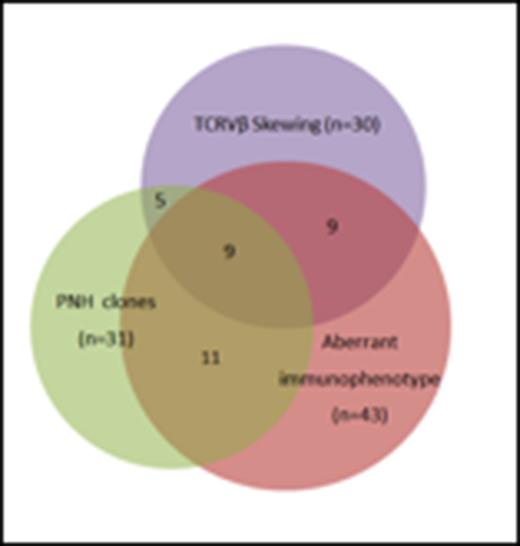Abstract
Refractory cytopenia of childhood (RCC) is the most common subtype of childhood myelodysplastic syndrome (MDS). Clinical and laboratory evidence suggest a T-cell mediated pathophysiology in a subset of adult patients with low-grade MDS.Recently, it was shown that in RCC, indicators of an immune-mediated pathophysiology are frequently present. These indicators included the presence of minor paroxysmal nocturnal haemoglobinuria (PNH) clones and T cell receptor (TCR) β-chain variable (Vβ) domain (TCRVβ) skewing. In addition, aberrant immunophenotypes are frequently identified in RCC patients.
It is however still unknown to what extend these immune phenomena concomitantly occur in low-grade MDS. Therefore, in the current study we integrated the presence of minor PNH clones, TCRVβ skewing and immunophenotypic aberrancies in a large international cohort of 72 RCC patients.
Small PNH clones were present in 31 cases (43%), TCRVβ skewing in 30 cases (42%), and immunophenotypic aberrancies in 43 cases (60%). In only 9 patients (13%) all these three were present. Two parameters were present in 25 patients (35%), and 27 patients (38%) displayed only one parameter. In 11 patients (15%) none of the three characteristics was present.
The most prominent parameter was the presence of an aberrant immunophenotype, which was associated with TCRVβ skewing (n=18) or the presence of PNH clones (n= 20) in a subset of the patients. Hypocellular RCC patients with a small PNH clone (>0.1%) were more likely to respond to IST than PNH negative patients (88% versus 40% of patients responded at six months, respectively, P=0.038). From the current study we could not predict the strongest predictable value of combined parameters, with respect to response on immunosuppressive therapy (IST) in RCC patients, as only 23 patients were treated with IST.
We conclude that RCC patients frequently show immunological aberrancies, but that the presence of and combination with PNH and TCRVB skewing is rather heterogeneous. However, our study underscores the fact that in RCC, which might be challenging to diagnose based on morphology only due to hypoplasia, bone marrow immunophenotyping by flow cytometry, combined with either TCRVβ skewing or the presence of PNH clones, may be of important diagnostic value. Future studies in extended RCC series are required to build a prediction model for response to immunosuppressive therapy.
Venn diagram depicting the overlap between flow cytometric aberrant immunophenotype, PNH clones and TCRVβ skewing in RCC.
Venn diagram depicting the overlap between flow cytometric aberrant immunophenotype, PNH clones and TCRVβ skewing in RCC.
Langerak:Roche: Other: Lab services in the field of MRD diagnostics provided by Dept of Immunology, Erasmus MC (Rotterdam); In Vivo Scribe: Patents & Royalties: Licensing of IP and Patent on BIOMED-2-based methods for PCR-based Clonality Diagnostics. DAKO: Patents & Royalties: Licensing of IP and Patent on Split-Signal FISH. Royalties for Dept. of Immunology, Erasmus MC, Rotterdam, NL.
Author notes
Asterisk with author names denotes non-ASH members.


